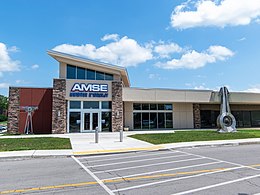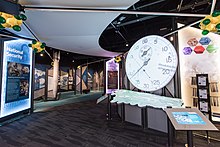
The Manhattan Project was a research and development undertaking during World War II that produced the first nuclear weapons. It was led by the United States in collaboration with the United Kingdom and with support from Canada. From 1942 to 1946, the project was under the direction of Major General Leslie Groves of the U.S. Army Corps of Engineers. The nuclear physicist J. Robert Oppenheimer was the director of the Los Alamos Laboratory that designed the bombs. The Army component was designated the Manhattan District, as its first headquarters were in Manhattan; the name gradually superseded the official codename, Development of Substitute Materials, for the entire project. The project absorbed its earlier British counterpart, Tube Alloys. The Manhattan Project grew rapidly and employed nearly 130,000 people at its peak and cost nearly US$2 billion. Over 90 percent of the cost was for building factories and to produce fissile material, with less than 10 percent for development and production of the weapons. Research and production took place at more than 30 sites across the United States, the United Kingdom, and Canada.

Oak Ridge National Laboratory (ORNL) is a federally funded research and development center in Oak Ridge, Tennessee, United States. Founded in 1943, the laboratory is now sponsored by the United States Department of Energy and administered by UT–Battelle, LLC.

Oak Ridge is a city in Anderson and Roane counties in the eastern part of the U.S. state of Tennessee, about 25 miles (40 km) west of downtown Knoxville. Oak Ridge's population was 31,402 at the 2020 census. It is part of the Knoxville Metropolitan Area. Oak Ridge's nicknames include the Atomic City, the Secret City, and the City Behind the Fence.
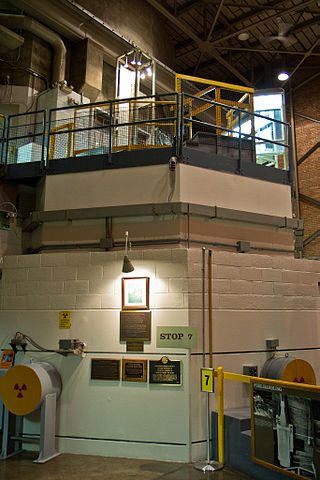
Experimental Breeder Reactor I (EBR-I) is a decommissioned research reactor and U.S. National Historic Landmark located in the desert about 18 miles (29 km) southeast of Arco, Idaho. It was the world's first breeder reactor. At 1:50 p.m. on December 20, 1951, it became one of the world's first electricity-generating nuclear power plants when it produced sufficient electricity to illuminate four 200-watt light bulbs. EBR-I subsequently generated sufficient electricity to power its building, and continued to be used for experimental purposes until it was decommissioned in 1964. The museum is open for visitors from late May until early September.


The Y-12 National Security Complex is a United States Department of Energy National Nuclear Security Administration facility located in Oak Ridge, Tennessee, near the Oak Ridge National Laboratory. It was built as part of the Manhattan Project for the purpose of enriching uranium for the first atomic bombs. It is considered the birthplace of the atomic bomb. In the years after World War II, it has been operated as a manufacturing facility for nuclear weapons components and related defense purposes.

The National Atomic Testing Museum in Las Vegas, Nevada, documents the history of nuclear testing at the Nevada Test Site (NTS) in the Mojave Desert about 65 miles northwest of Las Vegas. The museum operates as an affiliate of the Smithsonian Institution.

The B Reactor at the Hanford Site, near Richland, Washington, was the first large-scale nuclear reactor ever built. The project was a key part of the Manhattan Project, the United States nuclear weapons development program during World War II. Its purpose was to convert natural uranium metal into plutonium-239 by neutron activation, as plutonium is simpler to chemically separate from spent fuel assemblies, for use in nuclear weapons, than it is to isotopically enrich uranium into weapon-grade material. The B reactor was fueled with metallic natural uranium, graphite moderated, and water-cooled. It has been designated a U.S. National Historic Landmark since August 19, 2008 and in July 2011 the National Park Service recommended that the B Reactor be included in the Manhattan Project National Historical Park commemorating the Manhattan Project. Visitors can take a tour of the reactor by advance reservation.
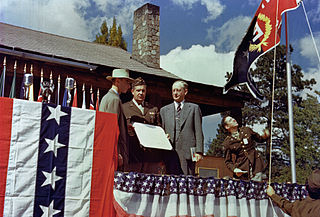
The Manhattan Project was a research and development project that produced the first atomic bombs during World War II. It was led by the United States with the support of the United Kingdom and Canada. From 1942 to 1946, the project was under the direction of Major General Leslie Groves of the US Army Corps of Engineers. The Army component of the project was designated the Manhattan District; "Manhattan" gradually became the codename for the entire project. Along the way, the project absorbed its earlier British counterpart, Tube Alloys. The Manhattan Project began modestly in 1939, but grew to employ more than 130,000 people and cost nearly US$2 billion. Over 90% of the cost was for building factories and producing the fissionable materials, with less than 10% for development and production of the weapons.
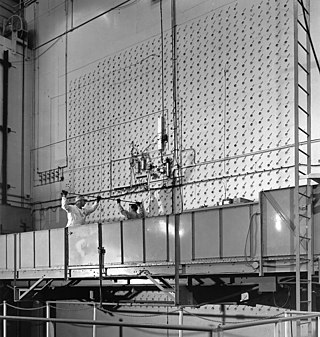
The X-10 Graphite Reactor is a decommissioned nuclear reactor at Oak Ridge National Laboratory in Oak Ridge, Tennessee. Formerly known as the Clinton Pile and X-10 Pile, it was the world's second artificial nuclear reactor, and the first designed and built for continuous operation. It was built during World War II as part of the Manhattan Project.

Atomic tourism or nuclear tourism is a recent form of tourism in which visitors learn about the Atomic Age by traveling to significant sites in atomic history such as nuclear test reactors, museums with nuclear weapon artifacts, delivery vehicles, sites where atomic weapons were detonated, and nuclear power plants.
The Atomic Heritage Foundation (AHF) is a nonprofit organization originally based in Washington, DC, dedicated to the preservation and interpretation of the Manhattan Project, the Atomic Age, and its legacy. Founded by Cynthia Kelly in 2002, the Foundation's stated goal is, "to provide the public not only a better understanding of the past but also a basis for addressing scientific, technical, political, social and ethical issues of the 21st century." AHF works with Congress, the Department of Energy, the National Park Service, state and local governments, nonprofit organizations and the former Manhattan Project communities to preserve and interpret historic sites and develop useful and accessible educational materials for veterans, teachers, and the general public. In June 2019, the Atomic Heritage Foundation and the National Museum of Nuclear Science & History signed an agreement that granted stewardship of the Atomic Heritage Foundation website and all of the AHF's physical collections to the museum. The Atomic Heritage Foundation website is now run by the National Museum of Nuclear Science & History. Additionally, the museum now houses the Atomic Heritage Foundation's physical collections which have been integrated into the Nuclear Museum's own collection.

The National Museum of Nuclear Science & History is a national repository of nuclear science information chartered by the 102nd United States Congress under Public Law 102-190, and located in unincorporated Bernalillo County, New Mexico, with an Albuquerque postal address. It is adjacent to both the Albuquerque city limits and Kirtland Air Force Base.

Major General Kenneth David Nichols CBE was an officer in the United States Army, and a civil engineer who worked on the secret Manhattan Project, which developed the atomic bomb during World War II. He served as Deputy District Engineer to James C. Marshall, and from 13 August 1943 as the District Engineer of the Manhattan Engineer District. Nichols led both the uranium production facility at the Clinton Engineer Works at Oak Ridge, Tennessee, and the plutonium production facility at Hanford Engineer Works in Washington state.

James Edward Westcott was an American photographer who was noted for his work with the United States government in Oak Ridge, Tennessee, during the Manhattan Project and the Cold War.
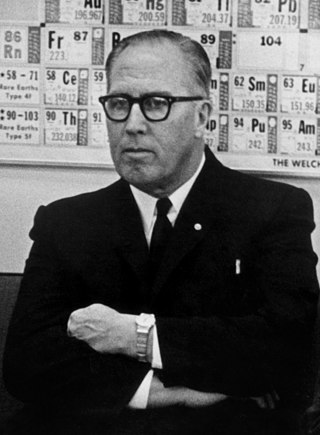
Clarence Edward Larson was an American chemist, nuclear physicist and industrial leader. He was involved in the Manhattan Project, and was later director of Oak Ridge National Laboratory and commissioner of the U.S. Atomic Energy Commission.

Manhattan Project National Historical Park is a United States National Historical Park commemorating the Manhattan Project that is run jointly by the National Park Service and Department of Energy. The park consists of three units: one in Oak Ridge, Tennessee, one in Los Alamos, New Mexico and one in Hanford, Washington. It was established on November 10, 2015 when Secretary of the Interior Sally Jewell and Secretary of Energy Ernest Moniz signed the memorandum of agreement that defined the roles that the two agencies had when managing the park.
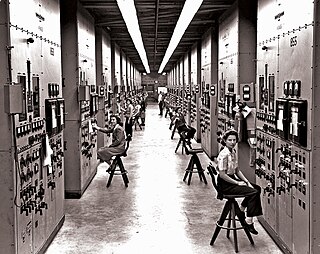
The Calutron Girls were a group of young women, mostly high school graduates, who joined the Manhattan Project, the World War II efforts to develop nuclear weapons at the United States government facility located at Oak Ridge, Tennessee, between 1943 and 1945. Although they were not allowed to know at the time, they were monitoring dials and watching meters for calutrons, mass spectrometers adapted for separation of uranium isotopes. The enriched uranium was used to make the "Little Boy" atomic bomb for the Hiroshima nuclear bombing on August 6, 1945.
African-American scientists and technicians on the Manhattan Project held a small number of positions among the several hundred scientists and technicians involved. Nonetheless, African-American men and women made important contributions to the Manhattan Project during World War II. At the time, their work was shrouded in secrecy, intentionally compartmentalized and decontextualized so that almost no one knew the purpose or intended use of what they were doing.

